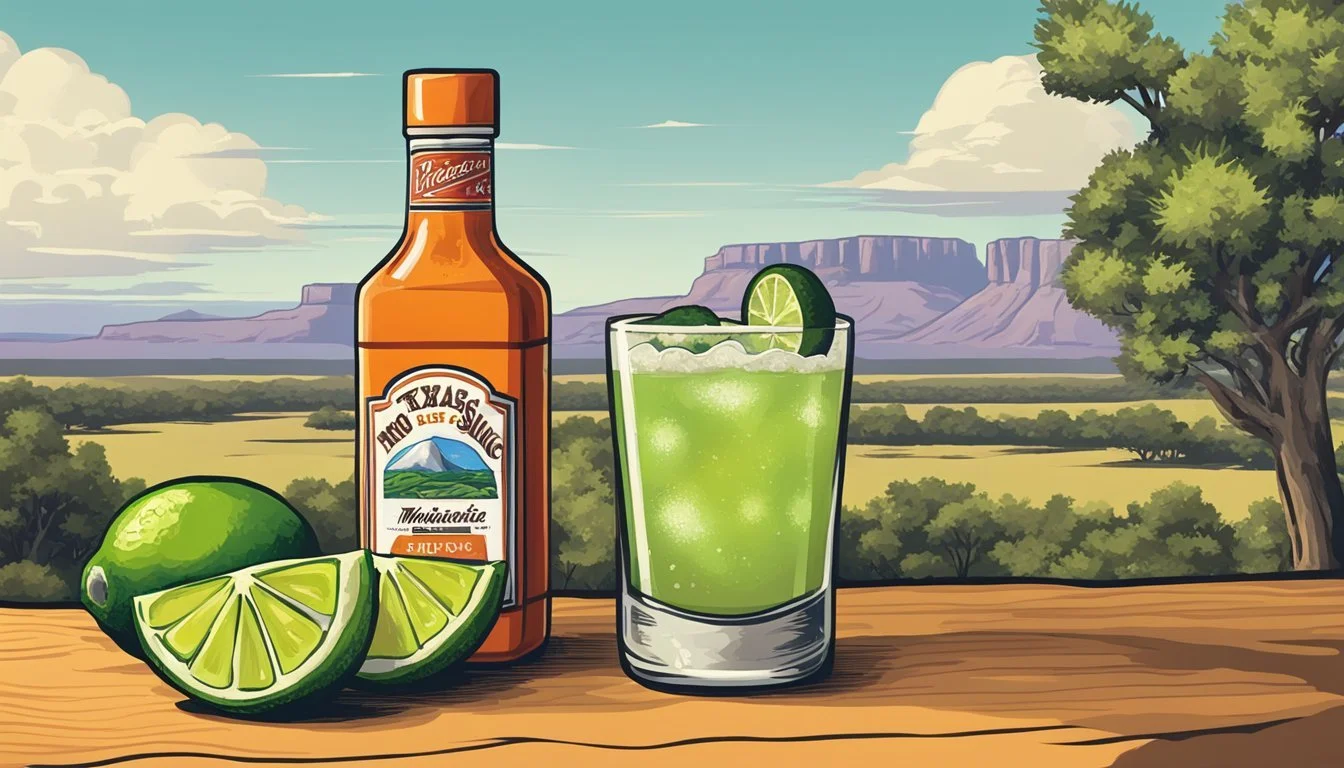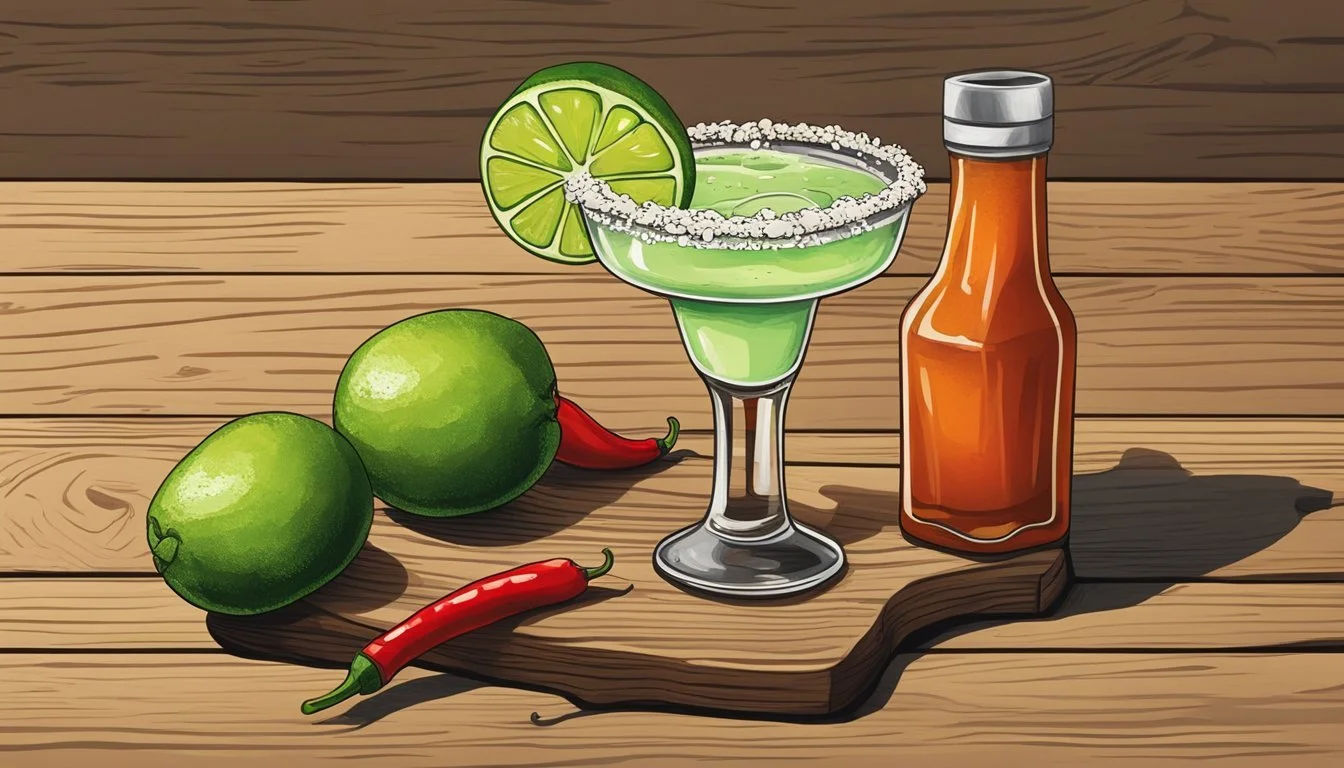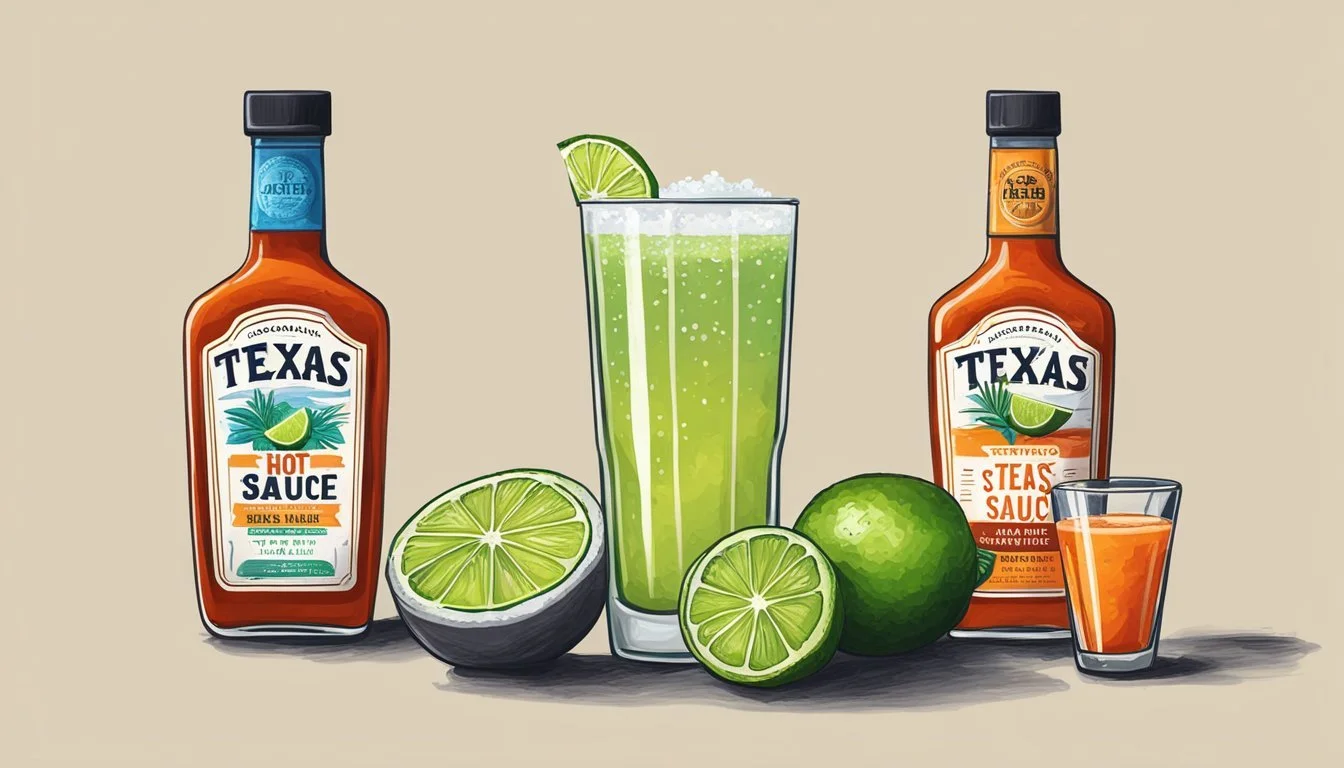The Best Texas Hot Sauce and Margarita Pairings
A Guide to Spicy and Sippable Combos
Texas is renowned for its bold flavors, particularly when it comes to its hot sauce and margaritas. These two staples have come to define the culinary landscape of the region, offering a taste of the Lone Star State's spirit in every drop and sip. Texas hot sauces often carry a signature heat that is both assertive and nuanced, while Texas margaritas are famous for their balance of sweetness and sourness, with a robust tequila backbone.
Pairing these two can enhance a dining experience, providing a fusion of heat and refreshment. The art of pairing hot sauce with a margarita lies in matching the intensity and flavor profile of the sauce with the right kind of margarita. A classic Texas Margarita, with its straightforward lime juice and tequila mix, might be the perfect canvas for a variety of hot sauces from smoky to tangy.
In exploring the best Texas hot sauce and margarita pairings, one will quickly realize the diversity among regional recipes and local preferences. The unique elements of each hot sauce—whether it be the type of peppers used or the addition of local ingredients like Texas peaches or pecans—call for margaritas that can complement and contrast these flavors. Understanding this interplay elevates the dining experience, allowing each element to shine while creating a harmonious flavor profile.
History and Origin of the Classic Margarita
The classic Margarita is a traditional cocktail that has woven its way through Texan hospitality fine-tuned by Mexican cuisine and culture. It's a blend of tequila, lime juice, and orange liqueur, typically served with a salt rim.
Evolution of the Texas Margarita
The Texas Margarita, an adaptation of the classic cocktail, has become synonymous with Texan culture. It is known for its slushy texture, a result of being served frozen. The first frozen margarita machine was invented by Mariano Martinez on May 11, 1971, in Dallas, Texas. This innovative creation stemmed from the need to consistently produce the perfect frozen drink and has since become a staple in Texan bars and restaurants.
Ingredient Classic Margarita Texas Margarita Tequila Base spirit Base spirit Lime Juice Adds tartness Balances sweetness Orange Liqueur Sweetness & complexity Often replaced with agave nectar Salt Rim Enhances flavor profile Common in both varieties
Influence of Mexican Cuisine and Culture
The Margarita has origins deeply rooted in Mexican culture, with various stories attributing its invention to Mexican bartenders seeking to please American clientele. One prevalent tale dates back to 1938, identifying Carlos "Danny" Herrera as the creator for an actress allergic to all hard liquor but tequila. Herrera reportedly combined tequila, lime juice, and Cointreau to craft the now-iconic beverage. As Mexican cuisine emphasizes fresh, bold flavors, the Margarita complements it excellently, with its citrus brightness cutting through spicy dishes (What wine goes well with spicy dishes?) and providing an invigorating counterbalance.
Essentials of a Great Margarita
Crafting the perfect margarita is an art that combines high-quality ingredients with precision in balancing flavors. Here are the foundational elements that are non-negotiable for this iconic Texan cocktail.
Choosing the Right Tequila
The selection of tequila is paramount in a margarita recipe. A premium, high-quality blanco or reposado tequila is recommended for its smooth and nuanced flavor profile. Blanco tequilas contribute a crisp, pure agave taste, perfect for a vibrant cocktail, while reposado tequilas introduce a subtle oak complexity from barrel aging, enhancing the depth of the drink.
Balance of Flavors
Achieving a harmonious balance of flavors is crucial. Margaritas should hit the sweet, sour, and bitter notes without overpowering any element. Commonly, a recipe includes:
Tequila: The spirit base.
Fresh lime juice: For tartness and acidity.
Triple sec or Grand Marnier: Orange liquors that add a citrusy sweetness.
Agave nectar or simple syrup: To fine-tune sweetness.
A salt-rimmed glass: To contrast and elevate the taste.
Tasting and adjusting according to the recipe or individual preference is key to achieving balance.
The Importance of Fresh Lime Juice and Citrus
Freshly squeezed lime juice is a non-negotiable component due to its bright and tangy flavor. Margaritas often include other citrusy elements, such as fresh orange juice or a lime wedge garnish, to enhance the refreshing character of the cocktail. The freshness of these ingredients contributes to the zesty aroma and taste that defines a great margarita.
Variations of the Classic Margarita
While the classic margarita is beloved for its simple blend of tequila, lime juice, and orange liqueur, adventurous mixologists have spun this traditional cocktail into a bevy of sophisticated variations. These include infusions of heat, smokiness, and an assortment of fruity flavors to cater to a range of palates.
Spicy Jalapeño Margarita
For those who prefer a zesty kick, the Spicy Jalapeño Margarita turns up the heat. This fiery twist on the classic recipe involves muddling fresh jalapeños with the base ingredients and sometimes adding a pinch of cayenne for extra warmth. It's typically garnished with a spicy salt rim, further amplifying the heat.
Mezcal Margarita
The Mezcal Margarita introduces a smoky profile by using mezcal, a spirit distilled from agave like tequila but with a distinctive, earthy flavor. This cocktail retains the orange liqueur and lime juice of the classic margarita but substitutes tequila for mezcal to provide a deeper, more nuanced taste.
Fruity and Tropical Margaritas
For a sweet escape, Fruity and Tropical Margaritas are a refreshing choice. Popular variations include the Mango Margarita, which blends ripe mangoes into the mix, and the Watermelon Margarita, which offers a juicy, summery twist. Both can be served frozen or on the rocks, adorned with fruit garnishes that hint at their luscious contents.
Unique Twists: Cold Brew and Breakfast Margaritas
Innovative takes on the classic include the Cold Brew Margarita, a bold combination of cold brew coffee and traditional margarita ingredients, creating a cocktail that's as stimulating as it is satisfying. Another unique concoction is the Breakfast Margarita, which pairs well with brunch favorites like breakfast tacos. Fresh raspberries might be muddled or introduced as a syrup, transforming the classic margarita into a morning-friendly delight.
Classic Texas Hot Sauces
Texas hot sauces are renowned for their robust flavors and regional flair, often incorporating local ingredients such as jalapeños and habanero peppers. They offer a range of heat levels to satisfy a variety of palates.
Profile of Texas Hot Sauces
Texas hot sauces typically embody a zestful blend where heat is balanced with flavor. Habanero peppers frequently feature for their fiery kick, while the inclusion of onion, garlic, and lime juice contributes depth and brightness. These sauces frequently weave in a characteristic smoky flavor, reflective of Texan love for barbecued cuisine. Unlike sauces such as Sriracha or Sambal Oelek which lean toward Asian flavor profiles, Texas sauces are distinctly American Southwest.
Common Peppers and Ingredients
Pepper Type Description Common Use Case Jalapeños A staple in Texan cuisine providing a mild to moderate heat. Salsas, marinades, and mild hot sauces. Habanero Offers a much higher heat level and a fruity-citrusy flavor. Used in spicier hot sauces for an extra kick. Tabasco Not native to Texas but can be found in some Texan hot sauces for its vinegar-forward tang. Classic hot sauces with a vinegar base. Cholula A brand often used that includes both piquin and arbol peppers, known for its signature taste. Table sauce for adding a moderate spice to dishes.
In addition to the peppers, Texas hot sauces commonly utilize organic ingredients to elevate their flavor profiles. Garlic and onion add savoriness, while lime juice introduces acidity and freshness, which can complement the malty notes of a Corona beer in a pairing. The use of such ingredients solidifies Texas hot sauces as a go-to condiment that transcends simply adding heat.
Perfecting the Hot Sauce and Margarita Pairing
When it comes to elevating your dining experience, matching the heat of a Texas hot sauce with the refreshing zst of a margarita can create a harmonious balance. This section explores how to pair these bold flavors effectively.
Spice Levels and Margarita Matches
In pairing hot sauces with margaritas, one must consider the spice level of the sauce and the style of the margarita. Here's how one can match different Scoville heat units with appropriate margarita variations:
0 to 2,500 Scoville units (Mild): A classic margarita with a salted rim complements mild hot sauces without overpowering the palate.
2,500 to 30,000 Scoville units (Medium): A spicy jalapeño margarita can stand up to medium-hot sauces, offering a cohesive flavor profile.
Above 30,000 Scoville units (Hot to Extremely Hot): Balance the intense heat of these sauces with a sweeter margarita or one with cooling elements like cucumber.
Pairing with Food: Tacos and More
When incorporating tacos into the hot sauce and margarita equation, selecting the right combination is crucial for a pleasing culinary experience. Here's a brief guide:
Baja Fish Tacos: A tangy, vinegar-based hot sauce and a classic margarita with a hint of lime amplify the taste of the seafood.
Birria Tacos: The deep, rich flavor of birria pairs well with a creamy-textured hot sauce and a classic margarita, possibly with a smoky element like mezcal.
Tex-Mex Tacos: Opt for a green jalapeño hot sauce to bring out the bright flavors in the tacos, along with a spicy jalapeño margarita for a uniform flavor.
Barbacoa Tacos: A smoky chipotle hot sauce necessitates a balanced margarita with sweet and sour notes to cut through the richness.
Experimenting beyond tacos, classic Texas hot sauces can also enrich the flavors of pizza, wings, and an array of Asian dishes when served with a fitting margarita, ensuring a versatile and enjoyable dining experience.
The Art of Garnishing
The garnish on a margarita not only adds visual appeal but also enhances its flavor. While the perfect pour of tequila and the balance of lime juice are central to a great margarita, it's the garnish that crowns the cocktail and invites the first sip.
Salt Rims and Fresh Fruit
A salt-rimmed glass is iconic to the margarita experience. It's important to use coarse salt for texture and coverage. To achieve this:
Circle the rim of the glass with a lime wheel to moisten it.
Dip the edge of the glass into coarse salt, ensuring it is evenly coated.
A garnish of fresh lime wheel or a twist of orange zest can be added for a citrusy aroma.
Herbs and Spices for an Extra Kick
In addition to fruit, consider enhancing the margarita with herbs and spices:
Add a sprig of fresh mint or basil for an aromatic touch.
For a spicier kick, rim the glass with a mixture of salt and chili powder or incorporate ground spices directly into the salt rim.
These garnishing details not only complement the flavors of the Texas hot sauce used in the margarita but also serve as a feast for the eyes, preparing the palate for the first taste.
Serving and Presentation
Choosing the appropriate glassware and presenting hot sauce with style are two essential elements to enhance the enjoyment of Texas Margaritas and hot sauces. This section offers specific guidance on selecting the right glasses and tips on showcasing hot sauce to create a visually appealing and tasting experience.
The Right Glassware for Margaritas
Glassware plays a pivotal role in the Margarita experience. The traditional margarita glass, with its wide rim and distinctive bowl shape, is designed to showcase the drink's color and allows ample space for a salted rim. Here's a quick breakdown:
Stemmed Margarita Glasses: Ideal to keep the drink cold as the stem prevents hands from warming the contents.
Rocks Glasses: A good choice for a margarita served on the rocks; their wide brim supports a generous salt rim.
For those preparing Margaritas in larger batches, a sturdy pitcher is a practical addition. It ensures guests can easily serve themselves while the host enjoys the festivities.
Presentation Tips for Hot Sauce
Hot sauce presentation should be both functional and inviting. A small dish or ramekin allows for easy dipping or drizzling, and using clear containers can show off the sauce's color and texture. Consider the following:
Consistency: Whether thick or thin, the hot sauce's texture should inform the choice of serving dish.
Complementing Flavors: If pairing hot sauce with a Margarita, consider how the spice level interacts with the drink's citrusy profile.
Utensils like a cocktail shaker and a citrus juicer are vital for the flawless execution of a Margarita, ensuring that the flavors are well-mixed and that fresh lime juice is readily available to balance the hot sauce's heat. When serving, one might also consider the addition of ice cubes if the Margaritas are to be served on the rocks to keep them refreshingly chilled.
Culinary Tourism in Texas
Texas offers a rich tapestry of flavors, and its culinary scene is a vibrant blend of tradition and innovation. Visitors can immerse themselves in the local culture by exploring margarita and hot sauce trails and patronizing famous restaurants and bars.
Margarita and Hot Sauce Trails
In cities like Austin and San Antonio, travelers can embark on specialized trails that lead them through a selection of venues celebrated for their craft margaritas and locally-made hot sauces. These trails often include notable spots such as Candelilla Café at the Lajitas Golf Resort, where one can savor a unique prickly pear margarita.
Austin, known for its deep roots in Texas history, presents a variety of hot sauce and cocktail experiences. Visitors might start their journey at a locale near historic sites like the state capitol building and enrich their palates with a cocktail that merges regional ingredients with classic techniques.
Famous Restaurants and Bars
Texas is home to restaurants and bars that have cemented their status in the culinary world with their signature dishes and beverages. Authentic Tex-Mex restaurants offer patrons a chance to pair spicy, savory enchiladas with a range of margaritas — from the traditional lime to the more adventurous flavors featuring local fruits and spices.
San Antonio stands out with its culinary offerings, where enchiladas are draped in chili sauce and paired perfectly with a handcrafted margarita. Visitors are encouraged to visit during events like the Texas Hot Sauce Festival in Houston to sample innovative sauces and find inspiration for pairings.
Conclusion
Exploring the dynamic duo of Texas hot sauces and margaritas provides a delightful culinary experience. When considering pairings, one must account for the flavor profiles of both the beverage and the condiment. It is advised to balance the fiery kick of the hot sauce with the refreshing zing of a margarita, ensuring neither overpowers the other.
A classic Texas Margarita, known for its bold citrus notes, pairs wonderfully with a moderately spicy hot sauce. This combination allows each component to shine without overwhelming the palate. Experiment with homemade hot sauce recipes incorporating local peppers to achieve authentic Texan heat.
In terms of cooking tips, freshly made condiments and cocktails will enhance the dining experience. When creating a margarita, use fresh lime juice and high-quality tequila. Similarly, for hot sauce, select fresh ingredients and consider roasting peppers to deepen their flavor.
Here's a simple hot sauce-margarita pairing to consider:
Traditional Texas Margarita
Ingredients: Tequila, Cointreau, lime juice, agave syrup
Pair with: Salsa-style hot sauce with a tomato base
By keeping balance in mind, one can create a delightful interplay between spicy and tangy notes. Enthusiasts can confidently expand their culinary horizons by exploring these pairings, making every meal an adventurous and satisfying experience.










